

How to Assess a Lesson Plan. Based on Instructional Planning for Effective Teaching All teachers engage in certain levels of strategic and tactical planning.
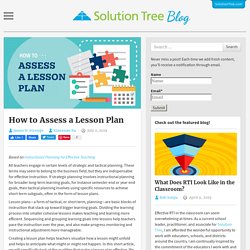
These terms may seem to belong to the business field, but they are indispensable for effective instruction. If strategic planning involves instructional planning for broader long-term learning goals, for instance semester-end or year-end goals, then tactical planning involves using specific resources to achieve short-term subgoals, often in the form of lesson plans. Lesson plans—a form of tactical, or short term, planning—are basic blocks of instruction that stack up toward bigger learning goals. Dividing the learning process into smaller cohesive lessons makes teaching and learning more efficient. Creating a lesson plan helps teachers visualize how a lesson might unfold and helps to anticipate what might or might not happen.
Lesson Planning Quality 1: Clear Learning Objectives Lesson Planning Quality 2: Building on Prior Knowledge Some guiding questions are: Dr. Introduction. Standards Crosswalks - National School Library Standards. Neag Center for Creativity, Gifted Education, and Talent Development. Home - TL Guides. School Librarian Buzz - Exploring LibGuides for your School Library - Springshare Buzz at Springshare. They Haven’t Done the Reading. Again. Browse the Pedagogy Unbound archives or join our new teaching group.
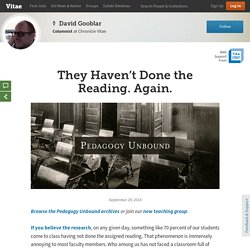
If you believe the research, on any given day, something like 70 percent of our students come to class having not done the assigned reading. That phenomenon is immensely annoying to most faculty members. Who among us has not faced a classroom full of blank stares, with seemingly no one prepared to answer the well-thought-out question we've asked about the reading? School Librarian's Role in Reading Toolkit. The NCTE Definition of 21st Century Literacies. Updated February 2013Adopted by the NCTE Executive Committee, February 15, 2008 Literacy has always been a collection of cultural and communicative practices shared among members of particular groups.
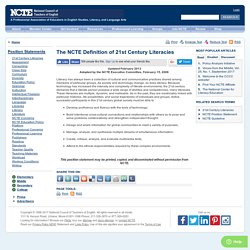
As society and technology change, so does literacy. Because technology has increased the intensity and complexity of literate environments, the 21st century demands that a literate person possess a wide range of abilities and competencies, many literacies. Collaborative Strategies for Teaching Reading Comprehension. Judi Moreillon The Web Supplements that support the lesson plans provided in Collaborative Strategies for Teaching Reading Comprehension are arranged here by chapter number.
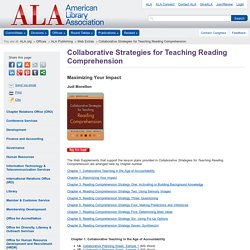
Chapter 1. School Librarians and the Common Core Standards: Resources. Impact: How-to Chapters. It is important to take advantage of the flexibility of the Internet to provide educators with resources that were not available at the time of the book's publication or that were not included in the book.
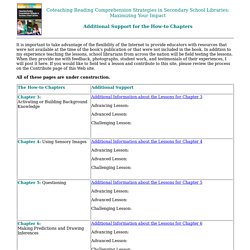
In addition to my experience teaching the lessons, school librarians from across the nation will be field testing the lessons. When they provide me with feedback, photographs, student work, and testimonials of their experiences, I will post it here. If you would like to field test a lesson and contribute to this site, please review the process on the Contribute page of this Web site. CCSSLibrariansBrief FINAL. Results on ReadWriteThink. Find content from Thinkfinity Partners using a visual bookmarking and sharing tool.
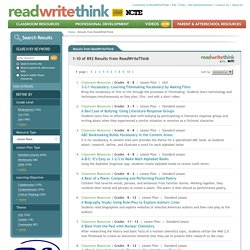
More. Reading in the Middle Grades - Reading Comprehension. Reading comprehensively is the process in which readers read a text and understand what they have read.
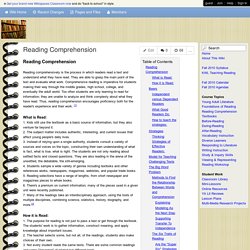
They are able to grasp the main point of the text and evaluate what work. Comprehensive reading is imperative for students making their way through the middle grades, high school, college, and eventually the adult world. TD1Lesson. Teaching Reading Comprehension Strategies. K-8 Comprehension Skills, Strategies, Activities & Exercises - Benchmark Education Storefront. Introduction/Overview This module explores comprehension strategies and their benefits.
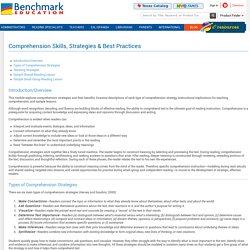
Examine descriptions of each type of comprehension strategy, instructional implications for teaching comprehension, and sample lessons. Although word recognition, decoding, and fluency are building blocks of effective reading, the ability to comprehend text is the ultimate goal of reading instruction. Comprehension is a prerequisite for acquiring content knowledge and expressing ideas and opinions through discussion and writing. Comprehension is evident when readers can: Predicting skills. Learning outcomes Students will: predict what is going to happen in a story. state three things to look for at the beginning of predicting (author, title, picture). change their predictions as the story is read to them.
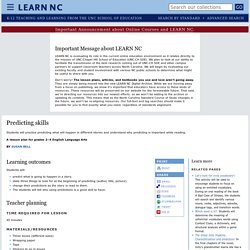
The students will tell why using predictions is a good skill to have. Teacher planning Time required for lesson 45 minutes Materials/resources. Wolves: Comprehending informational texts. Strategies for online reading comprehension. Imagine, if you will, that you are beside me as I peer over the shoulder of my twelve-year-old son.
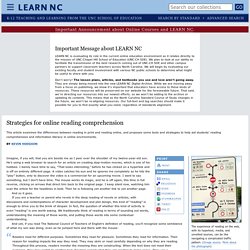
He’s using a web browser to search for an article on creating stop-motion movies, which is one of his hobbies. I barely have time to say, “That looks interesting,” before he has clicked on a hyperlink and is off on entirely different page. A video catches his eye and he ignores me completely as he hits the “play” button, only to discover the video is a commercial for an upcoming movie. I want to say something, but I don’t have time. The mouse works its magic, and he is off again, this time in full reverse, clicking on arrows that direct him back to the original page. And so it goes. How We Read the World Wide Web.